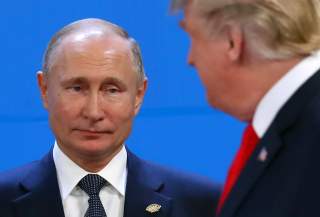America and Russia Must Agree to Avoid a New Arms Race
Public opinion has played a critical role in pushing leaders to negotiate nuclear agreements in the past. But will that remain true in the future?
A decade ago this month, President Barack Obama stood before a cheering crowd in Prague and said, “I state clearly and with conviction America’s commitment to seek the peace and security of a world without nuclear weapons.” Today, however, we are on the cusp of a world with more nuclear weapons, not fewer.
The future of U.S.-Russian arms control—a tradition of bilateral frameworks to reduce the threat of two superpowers instigating nuclear war dating back to Nixon and Brezhnev—looks dim. Once both countries officially leave the Intermediate-Range Nuclear Forces (INF) Treaty in August, there will remain only one formal agreement between the two nuclear possessors limiting the size and scope of their nuclear arsenals, the New Strategic Arms Reduction Treaty (START). And if that wasn’t enough, New START is due to expire in February 2021.
The Trump administration says it is looking into extending New START, however, there is cause for skepticism about this claim. U.S. National Security Advisor John Bolton—who’s gotten his way on the United States leaving the Iran Nuclear Deal and the INF Treaty—is a likely advocate for scrapping New START as well. In fact, he once bombastically referred to U.S. participation in the treaty as “Unilateral Disarmament.” Trump himself reportedly declined Putin’s offer of extending New START during their first official phone call.
Russia remains interested in extending the treaty beyond 2021, at least publicly. President Vladimir Putin has put out an open invitation for the two countries to begin discussions on an extension. Russian Foreign Minister, Sergey Lavrov expressed similar interest at this year’s Munich security conference. However, one should view Russia’s intent with a healthy amount of skepticism as well. Putin has expressed his disinterest in further bilateral agreements for several years, preferring a multilateral framework instead. As he explained in 2012, his concern is that the United States and Russia might wind up “endlessly disarming themselves while other nuclear powers would be building up arms.”
Without these agreements, Moscow and Washington could well be heading towards a new arms race, a possibility that Russian public and American public seem to have picked up on. According to a new survey conducted by the Chicago Council on Global Affairs and the Levada Analytical Center, seven in ten Russians (72 percent) and Americans (70 percent) say that it’s likely their countries are heading towards a new arms race.
Yet there is still reason for hope. Most Russians (87 percent) and Americans (74 percent) are in favor of Moscow and Washington coming to an agreement to limit nuclear weapons. This support matters most in the United States, which is where public opinion has played a critical role in pushing leaders to negotiate agreements in the past.
In 1986, Joseph Nye Jr. penned his Farewell to Arms Control, expressing his concerns that if negotiations between Ronald Reagan and Mikhail Gorbachev failed, the only agreed framework on strategic stability between the United States and the Soviet Union would be the Anti-Ballistic Missile Treaty. Reagan’s interest in the early 1980s in building up the U.S. nuclear arsenal stirred up public concern.
The Nuclear Freeze campaign—which included a protest of one million Americans calling for an end to the arms race—is credited with forcing Reagan’s hand to begin negotiations with Gorbachev in 1985. In 1982, three-quarters of Americans favored freezing production of nuclear weapons (75 percent), according to an NBC News/Associated Press poll. The plurality of Americans also disagreed with Reagan’s assertion that the freeze movement was being manipulated by foreign interests to weaken the country (48 percent). Reagan soon reversed course.
The differences between the 1980s and today are not insignificant. In 1982, the United States had lived through thirty-five years of the Cold War. Americans had practiced duck and cover drills in primary school and most Americans vividly remembered the Cuban Missile Crisis. Public sentiment was easier to utilize because of the constant threat of nuclear war.
In part, this explains why despite the support we see among Americans for a new arms control agreement and the sense that a new arms race is upon us, only 54 percent of Americans opposed the U.S. decision to withdraw from the INF Treaty. Like so much today, the INF decision has become a partisan issue, with 73 percent of Republicans supporting Trump’s decision to withdraw and 74 percent of Democrats opposing it. This, then, is the challenge for arms control advocates today; breaking through the partisanship that surrounds individual decisions on arms control.
Still, Americans remain pragmatic at heart. They seem to understand the value of arms control agreements. Even as 78 percent of the U.S. public describes Russia as a rival rather than a partner, Americans of all political affiliations still support pursuing new limits on the United States and Russian nuclear arsenals (90 percent Republican, 89 percent Democrat, 84 percent independent).
Lily Wojtowicz is a research associate at the Chicago Council on Global Affairs focusing on U.S.-Russian public opinion.
Image: Reuters

